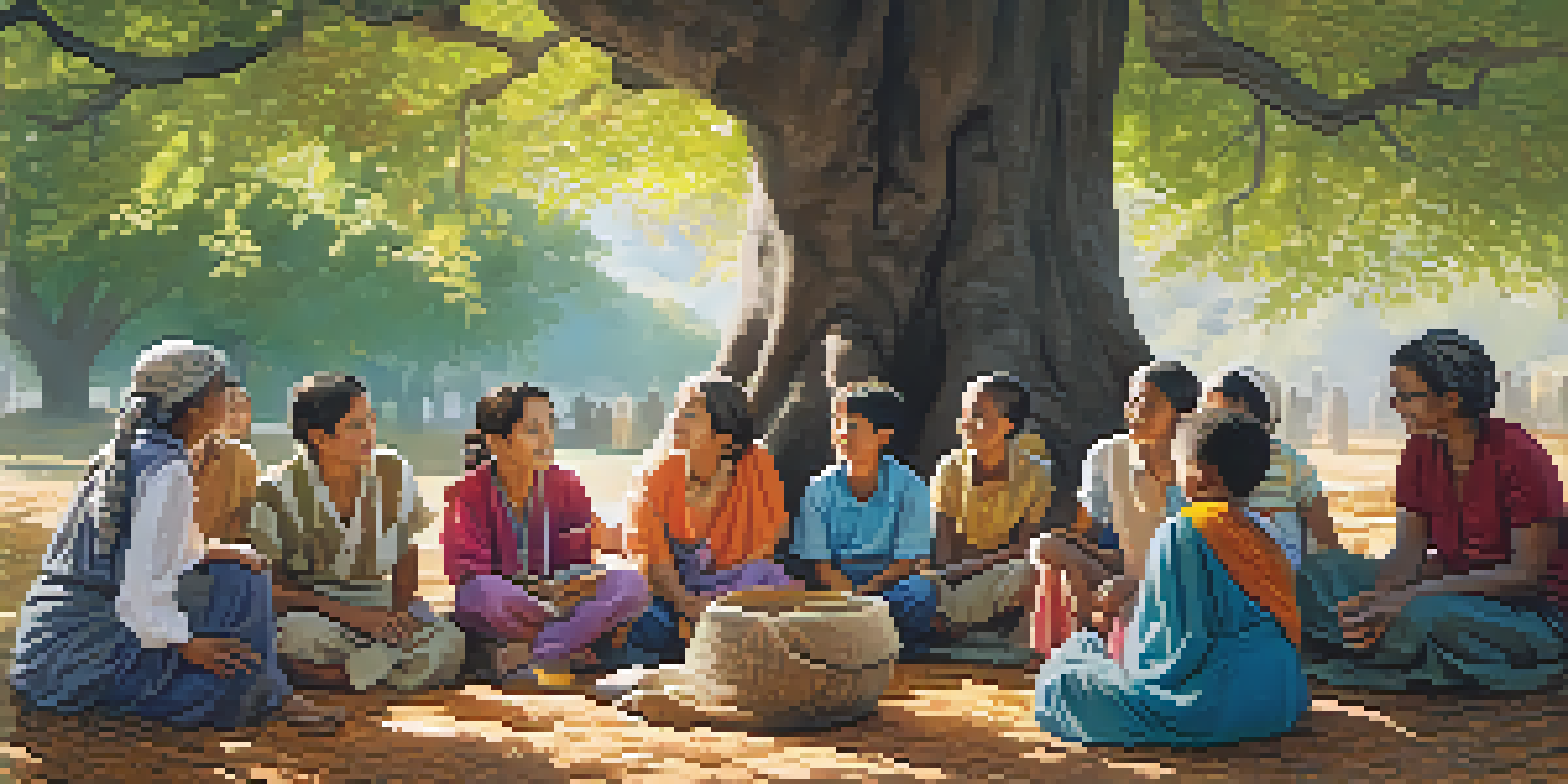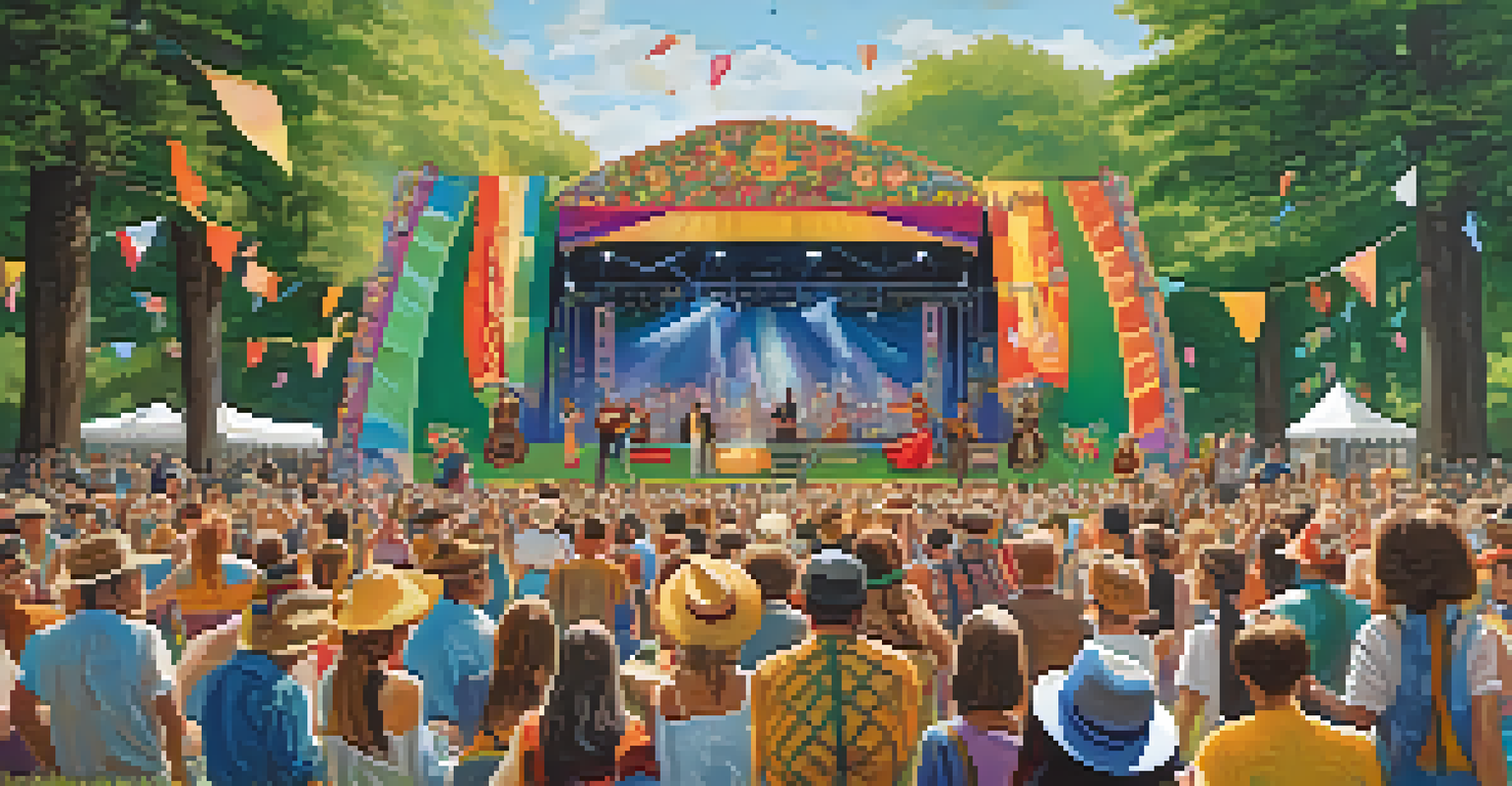The Significance of Oral Traditions in Music and Storytelling

Understanding Oral Traditions and Their Roots
Oral traditions are the age-old practices of passing down stories, songs, and cultural knowledge through spoken word rather than written text. They form the bedrock of many cultures, allowing communities to share their history and values across generations. For instance, in indigenous cultures, oral storytelling serves not only to entertain but also to instill moral lessons and cultural identity.
Stories are a communal currency of humanity.
These traditions often involve elements like rhythm and repetition, making them memorable and engaging. Think of how a catchy song can stay in your head long after you've heard it; that's the power of oral traditions at work. As societies evolved, the importance of these traditions remained, adapting to new contexts while retaining their core essence.
In a world dominated by digital media, the significance of oral traditions in music and storytelling endures. They remind us of our shared humanity, bridging gaps between different cultures and generations. Ultimately, they weave the fabric of community, ensuring that everyone has a voice in the collective narrative.
The Role of Music in Oral Traditions
Music has always played a pivotal role in oral traditions, serving as both a medium of expression and a mnemonic device. Songs can encapsulate complex stories and emotions, making them easier to remember and share. For example, consider the folk songs that recount historical events; they often provide a sense of place and identity for a community.

The rhythmic nature of music also enhances storytelling, allowing listeners to connect with the narrative on a deeper level. When a tale is set to melody, it becomes more engaging, inviting participation from the audience. Think about how lullabies soothe children; this demonstrates music's ability to convey emotion and meaning effectively.
Oral Traditions Preserve Culture
Oral traditions play a vital role in maintaining cultural identities and values across generations, especially in communities with scarce written records.
Moreover, music can transcend language barriers, making it a universal form of communication. In diverse societies, musical storytelling can unite people from different backgrounds, fostering a sense of belonging. Thus, music not only enriches oral traditions but also serves as a powerful tool for cultural exchange.
Storytelling Techniques Found in Oral Traditions
Oral storytelling employs various techniques that enhance the listener's experience, such as vivid imagery, character development, and suspense. These techniques help create a connection between the storyteller and the audience, immersing them in the narrative. For instance, a storyteller might describe a bustling marketplace, allowing listeners to visualize the scene and feel as if they are part of the story.
Music can change the world because it can change people.
Another common technique is the use of call-and-response, where the audience actively participates in the storytelling process. This interaction not only makes the experience more enjoyable but also reinforces the communal aspect of oral traditions. Imagine a group of friends sharing a favorite tale, echoing lines and adding their flair—this is the essence of oral storytelling.
Additionally, the repetition of certain phrases or ideas helps to reinforce important messages, making them more memorable. This method is often used in children's stories, where repeated lines encourage anticipation and engagement. Through these techniques, oral traditions ensure that stories are not just told but experienced.
Cultural Preservation Through Oral Traditions
Oral traditions play a crucial role in cultural preservation, particularly in communities where written records may be scarce. By passing down stories and songs, cultures can maintain their identities and values across generations. For instance, in many African cultures, griots (storytellers) are tasked with preserving the history of their people, ensuring that their heritage is not lost.
These traditions also foster a sense of belonging and continuity, as individuals feel connected to their ancestors through shared narratives. In this way, oral traditions create a living history, allowing communities to adapt while still honoring their past. Think of how family stories are often recounted at gatherings; they help reinforce connections and shared identity.
Music Enhances Storytelling
Music serves as a powerful tool in oral traditions, enriching narratives and fostering emotional connections through its rhythmic and memorable nature.
Moreover, as global cultures intersect, oral traditions can serve as vital links to cultural roots. They offer a way for marginalized voices to be heard, promoting diversity and understanding in an increasingly homogenized world. Thus, oral traditions not only safeguard history but also celebrate the richness of human experience.
The Impact of Technology on Oral Traditions
With the rise of technology, oral traditions are experiencing both challenges and opportunities. On one hand, digital media can dilute the authenticity of oral storytelling by creating a more passive consumption experience. For example, watching a video might not elicit the same emotional engagement as listening to a live storyteller, as the latter fosters a personal connection.
On the other hand, technology has also enabled the preservation and sharing of oral traditions on a global scale. Podcasts, social media, and video platforms allow storytellers to reach wider audiences, giving them a voice that transcends geographical boundaries. Consider how a traditional song from a remote village can now be streamed worldwide, connecting people through shared cultural expressions.
Additionally, technology offers new tools for storytellers to innovate their craft. By blending traditional narratives with modern mediums, they can create unique experiences that resonate with younger generations. Thus, while technology may change the landscape of oral traditions, it also provides avenues for their evolution and revitalization.
Interconnections Between Music and Storytelling
Music and storytelling are inherently intertwined, each enhancing the other in profound ways. Stories often serve as the foundation for songs, while music can add depth and emotion to narratives. For example, a ballad tells a tale of love or loss, inviting listeners to empathize with the characters and their journeys.
Moreover, music can set the tone for storytelling, influencing how a narrative is perceived. A lively tune might accompany a humorous tale, while a somber melody could enhance a tragic story. This interplay creates a richer experience for the audience, drawing them into the emotional landscape of the narrative.
Technology's Dual Impact
While technology poses challenges to the authenticity of oral traditions, it also offers innovative platforms for their preservation and global sharing.
In many cultures, music is a key component of storytelling traditions, with specific songs associated with certain stories or events. This symbiotic relationship ensures that both art forms continue to thrive, as they rely on each other for expression and meaning. Ultimately, the fusion of music and storytelling underscores their shared purpose: to convey human experiences and emotions.
The Future of Oral Traditions in a Changing World
As we look to the future, oral traditions must adapt to the changing landscape of communication and culture. While the digital age presents challenges, it also offers new ways to engage with these traditions. For instance, virtual storytelling events or online music festivals can bring communities together, even when physically apart.
Furthermore, there is a growing appreciation for the value of oral traditions in preserving cultural diversity. As more people seek authentic experiences, storytelling and music rooted in tradition may see a resurgence in popularity. Consider how folk festivals celebrate local culture; they provide a platform for oral traditions to thrive and evolve.

Ultimately, the resilience of oral traditions lies in their ability to adapt while remaining true to their core values. By embracing innovation while honoring heritage, these traditions can continue to enrich our lives and foster connections across generations. As the world changes, the stories we tell and the music we create will remain vital threads in the tapestry of human experience.